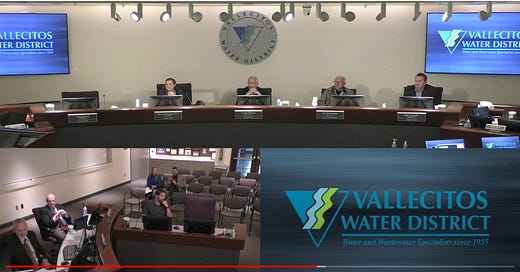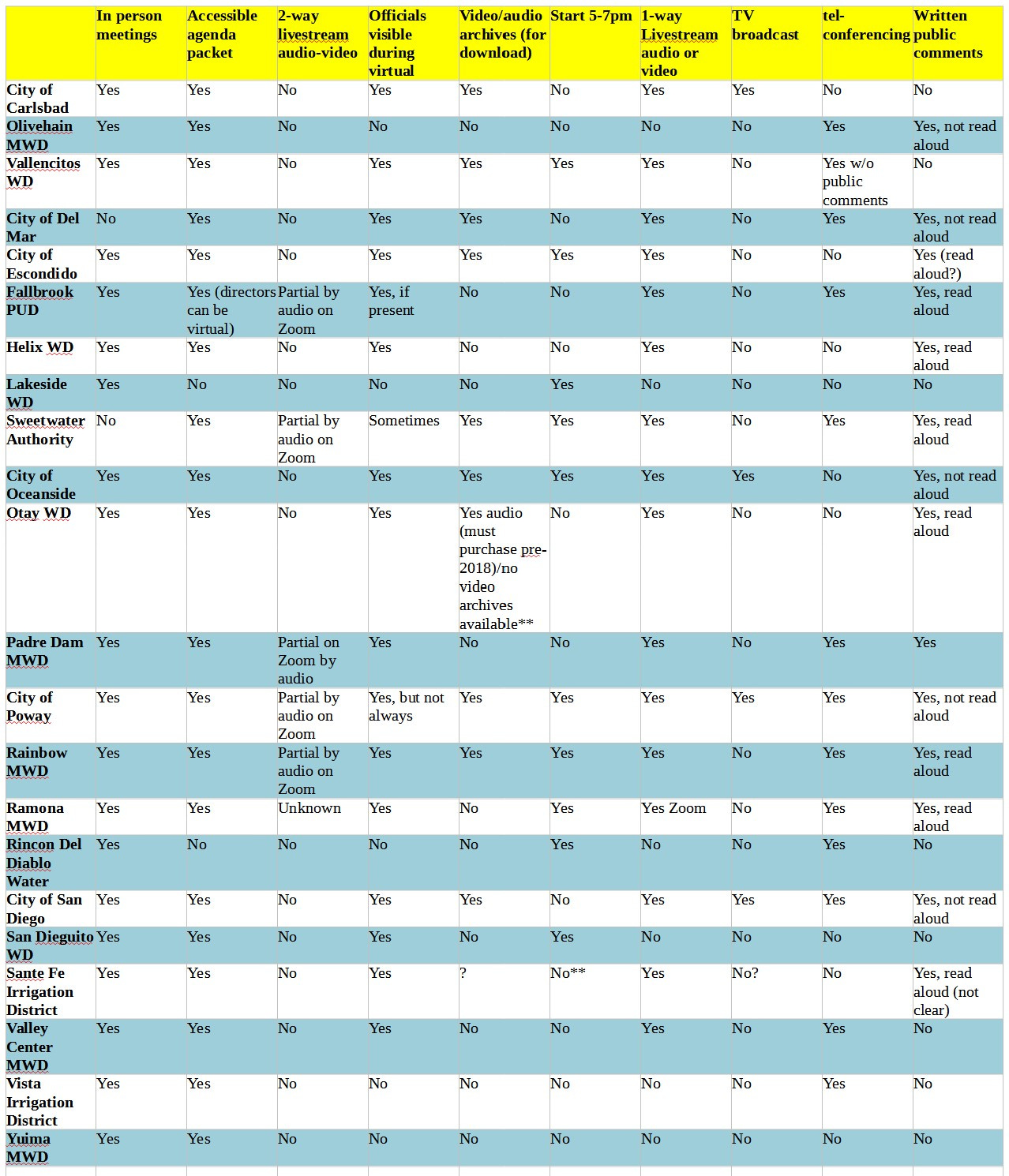How transparent is your local water agency? Here's a guide to San Diego County
State legislators and local water board directors have shown little interest in improving public access to public meetings, COVID-19 or not
“Public commissions, boards, councils and other legislative bodies of local government agencies exist to aid in the conduct of the people’s business. The people of this State do not yield their sovereignty to the agencies which serve them. The people, in delegating authority, do not give their public servants the right to decide what is good for the people to know and what is not good for them to know. The people insist on remaining informed so that they may retain control over the instruments they have created.”
—Preamble to the Ralph M. Brown Act, 1953, written by San Francisco Chronicle reporter Michael Harris
Note: a correction has been added at the end of this story to the transparency guide.
First, nothing I have written on the topic of open public meetings should be interpreted as an extension of Pandemic Denialism or COVID conspiracy theories, neither of which I have any interest in spreading. The fact is that COVID-19 continues to be real, but it and our reaction to it has evolved, for better or worse.
And so here we are: people on all sides of the pandemic-political-spectrum are exhausted, so they go where they want regardless, usually without wearing masks or practicing social distancing or showing any interest in going back to the “lockdown” that never really was.
Many local government bodies have been holding in-person public meetings for months, usually with recommendations of social distancing and mask wearing that fewer people follow everyday, even with an expected COVID-19 and flu surge already under way.
Bowing to political realities, if not science, Gov. Newsom will end the State’s COVID-19 caused State of Emergency in February, right in the middle of the predicted surge.
As a result, stricter pandemic protocols may come back or not. But for now, it’s a safe bet that the water board directors who have been voting to keep public meetings virtual-only, like Sweetwater Authority and the San Diego County Water Authority, using COVID-19 as their reason, ignore suggested pandemic protocols most everywhere else they go, like most people now do.
In the meantime, every local public governing body has the option to allow in-person meetings with or without social distancing and masks, as needed, a policy that must suffice for now.
And pandemic or not, there is no honest excuse for not expanding access to public meetings using modern livestreaming technology other than trying to protect self-imagined political fiefdoms.
The Waterboarding Transparency Guide for San Diego County that I have drawn up below is a first draft. I welcome any suggestions from readers for improving it.
The guide is presented in the spirit of the Brown Act and the First Amendment: that the ability of citizens to prevent or remedy injustices and errors made by their government depends on their ability to see and hear, and to be seen and heard by, their public officials in-person at public meetings where decisions are made.
The guide assumes that 21st Century technology can enhance the ability of the people to own and run their government, a concept that many water districts in Southern California have traditionally ignored to the best of their ability.
In that vein, the chart below notes whether the water districts listed in the left column, 22 member agencies of the San Diego County Water Authority (Camp Pendleton and National City, part of the Sweetwater Authority, are omitted), meet the following suggested protocols or not:
In person meetings
Accessible agenda packets
2-way livestreaming audio-video (meaning two-way visual and audio communication between members of the public and their public officials)
Public officials visible to the public when using virtual conferencing
Meetings start at the most convenient times (5-7pm)
1-way video livestreaming
TV broadcast (i.e. local cable)
Teleconferencing
Written public comments (by email, drop-off, or regular mail) and whether those comments are read aloud or not
Background
Brown Act amendments created by Gov. Newsom in 2020 due to the Pandemic and then codified in 2021 by AB 361, relaxed requirements for in-person public meetings, allowing government officials to hold virtual meetings (e.g. by Zoom) or by teleconferencing.
New and temporary amendments to the Brown Act start Jan 1st, 2023, under AB 2449. That bill will continue to allow local legislative bodies to attend meetings by livestream video, but only for some of its voting members for valid reasons (under the bill)—without the proclamation of a state of emergency required by AB 361, which expires at the end of 2023.
In return for expanding opportunities for some members of a local legislative body to appear virtually, AB 2449 applies stricter standards for virtual attendance, including two-way video/audio streaming between officials and members of the public.
More later, but for now suffice to say that the bill is a mixed blessing: it raises the transparency level for livestreaming meetings but also loosens requirements for public officials to appear in person, and it all expires in 2026.
In short, the bill temporarily but gratuitously extends Brown Act exceptions to the detriment of the public and wastes an opportunity to expand transparency for local government meetings permanently using the latest communications technology.
Note: Water districts without video livestreaming often discreetly audio-record all of their public meetings to help the board secretary write the minutes, without telling the public. And many water districts that do livestream their meetings don’t archive them online or tell the public how they can obtain and watch those meetings.
You can get around that subterfuge in two ways: 1) request a copy of the audio or video recording within 30 days from the date of the meeting (after that, the recording can be permanently deleted); and, or 2) for instant results, use screen capture software to record the livestreamed meeting onto your computer.
Further note: Currently, under AB 361, even if a local government body allows in-person attendance at meetings, it can still allow its legislators and other officials to attend virtually or by teleconferencing.
After AB 2449 kicks in, I will update this transparency guide and include water districts in Orange, Los Angeles, San Bernardino, and Riverside counties as well.
Correction made 11/24/2022 (the following was sent by Los Vallecitos Water District):
We recently saw your nice article about water district transparency. I work for Vallecitos Water District and just wanted to clarify two points for your table.
The last column in the table, Written Public Comments, lists Vallecitos as a “No”. We do allow written public comment. If we receive something in writing from a member of the public, we inform the Board and read it aloud at the meeting.
The second comment is about our board meetings being televised for transparency. In addition to in-person board meetings, the District also hosts virtual meetings and then plays the meetings at a later date on San Marcos TV. From our website vwd.org...
Vallecitos Water District is governed by a five-member Board of Directors, which meets every first and third Wednesday of each month at 5:00 p.m. Meetings can be attended in-person or viewed virtually.
In an effort to increase transparency to ratepayers, Vallecitos began airing its public meetings on San Marcos TV (SMTV) in August of 2013. Residents may tune into SMTV on Cox Communications Channel 19, Time Warner Channel 24 or AT&T U-verse Channel 99 to view the meetings, which will air as follows:
1st Wednesday Board Meeting - Airs on the Monday following the Wednesday meeting at 6:30 pm
3rd Wednesday Board Meeting - Airs on the Monday following the Wednesday meeting at 6:30 pm





